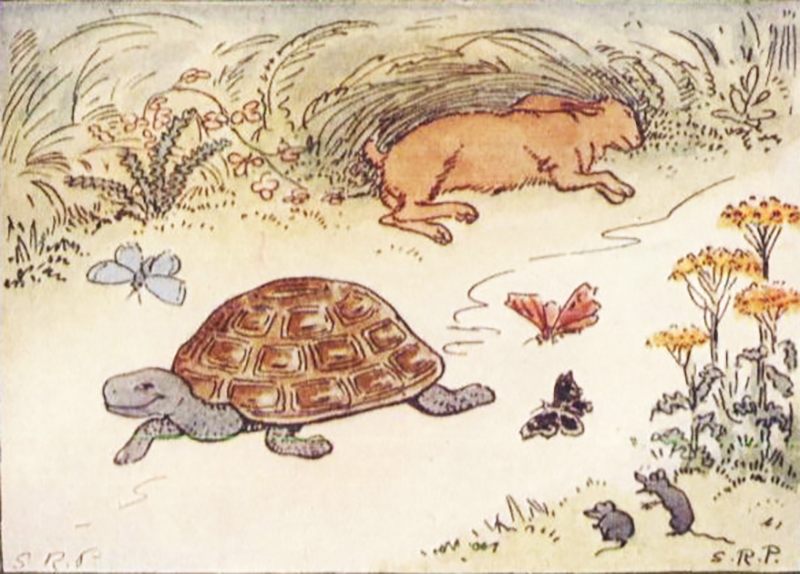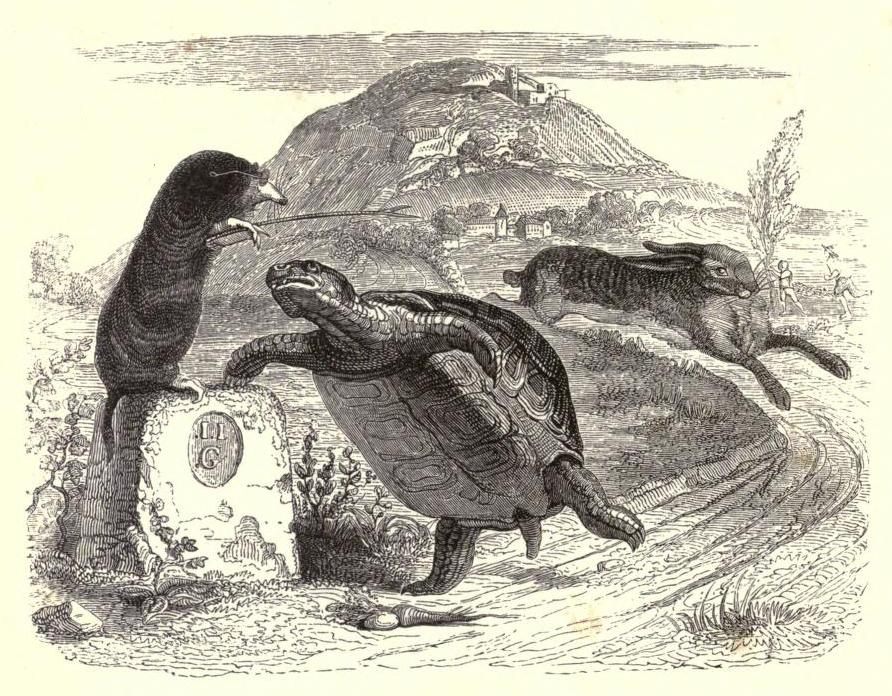Some Versions of ‘The Tortoise and the Hare’ Messed With the Moral
Slow and steady doesn’t always win the race.
Almost anyone growing up in an English-speaking culture knows the story of The Tortoise and the Hare. In the tale, the two animals challenge one another to a race to prove who is fastest: mid-race, the hare lays down to rest, certain that it’s going to win. Then out comes the tortoise, plodding along without pause, the winner; slow and steady wins the race, as the moral goes. Then there’s a huge forest fire, and almost everybody dies.
Wait, what?
Turns out, some versions of The Tortoise and the Hare have a little more to say. As one of Aesop’s Fables, a collection of stories passed down by word of mouth since ancient Greece, the story has gone through many iterations, though most vary only slightly. Sometimes the tortoise is starting the trouble instead of the boasting hare; usually, a fox is the judge of the contest, as it was with the first written versions on record. And sometimes, things get a little morbid.
In the Irish writer Lord Dunsany’s 1915 version of The Tortoise and the Hare, the decision to award and support the tortoise is based on an unfounded capitalist ethos. The woodland animals support the tortoise during the race, believing he will win because of his hard shell. “Hard shell and hard living. That’s what the country wants. Run hard,” say the animals, who creepily chant “Run hard” in unison as he passes the sleeping rabbit, who had stopped running, having decided that racing against no one was a ridiculous task. The tortoise wins, and is celebrated by all as the fastest animal in the forest. Dunsany lets us know why we don’t usually hear this “real” version of the story, though:
“…very few of those that witnessed it survived the great forest-fire that happened shortly after. It came up over the field by night with a great wind. The Hare and the Tortoise and a very few of the beasts saw it far off from a high bare hill that was at the edge of the trees, and they hurriedly called a meeting to decide what messenger they should send to warn the beasts in the forest.
They sent the Tortoise.”
Obviously, according to Dunsany, slow and steady only wins the race sometimes.

Another subversive version from 1891, by the poet George Murray, called The Hare and the Tortoise, flips the moral in another way. In Murray’s story, a hare named Puss sleeps during the race, seeing that she is likely to win—but this time, the hare wakes up just in time to catch her mistake, leaping from her slumber. “Scared by the sight, with all her speed and strength, she galloped in a winner by length!” Murray writes. No need to be slow and steady if you wake up paranoid and ready to make up for lost time.
The anonymous nature of Aesop’s fables make them perfect for rearranging or reinforcing morals, and since no one really owns the stories or whether Aesop ever actually existed, anyone can make their own version. Hundreds of years after Aesop’s supposed death in the 5th century BC, the stories were written down in Greek, translated into Latin, and were finally translated into English in 1494, after which they became the most widespread collection of European folk lore out there—but not all of the oral stories in the current Aesop’s collection existed in the first Greek translation; new ones were added over time. The Tortoise and the Hare seems to be one of these stories, and may have snuck into the lexicon later.

In the 1668 French version of the story from Fables by Jean de La Fontaine, Le Liervre et la Tortue, the tortoise gets a bit persnickety at the end, asking how fast the hare thinks he could go if he were carrying his house around on his back. A Latin version of the story, called De Lepore et Testudine, was illustrated and printed in 1687 for an English audience with the moral and story printed as a rhyme, which reads: “Mean parts by Industry have luckier hitts, Than all the fancy’d power of lazyer witts,” indicating brains and perseverance prevail over the station one is born into. This was right around the time England came up with its Bill of Rights.
A book of English emblems and their meanings, The English Emblem Tradition, even describes the Tortoise and the Hare story as a guide to love; one emblem shows the Greek god of attraction, Eros, who is “walking along the roadway in a landscape, with the tortoise” when he “looks back over his shoulder, pointing at the resting hare.”
Early on, the Tortoise and the Hare story also made a foray into philosophy; in 490 BC Greek philosopher Zeno created the Achilles and the Tortoise paradox, which describes a problem of motion. After the tortoise is given a head start against the legendary warrior Achilles; Zeno argues that based on math, Achilles should never be able to catch up if the tortoise keeps moving. Lewis Carroll, who was also a mathematician, had his own take on the Tortoise and Achilles paradox, which he brought to life in an 1895 issue of Mind:
“Achilles had overtaken the Tortoise, and had seated himself comfortably on its back.
“So you’ve got to the end of our race-course?” said the Tortoise. “Even though it does consist of an infinite series of distances? I thought some wiseacre or another had proved that the thing couldn’t be done?”
“It can be done,” said Achilles.”
This time, Achilles and the Tortoise end up sussing out the details of the paradox, with Achilles scribbling the logical steps toward their conclusion in a nearly-full notebook while riding happily on the tortoise’s back. Carroll lends fellow mathematicians a piece of advice; rules for a certain logic have to be carefully thought out without relying on assumed truths to carry the weight of the argument.

The Tortoise and the Hare has had many adaptations over the years, becoming such a part of western culture that it pops up in advertisements for cars and creepy love hotels, and even as an alternative name for an algorithm.
As for how a real tortoise and hare would fare in a race, that story has also played out—recently. In 2016, a turtle and rabbit (a close approximation to a tortoise and hare) were put to the test in real life to see who would win, competing in an original arena, and subsequent rematches. Each time, the tortoise won.









Follow us on Twitter to get the latest on the world's hidden wonders.
Like us on Facebook to get the latest on the world's hidden wonders.
Follow us on Twitter Like us on Facebook